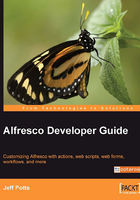
上QQ阅读APP看书,第一时间看更新
Summary
This chapter was about getting your development environment ready to go, providing an overview of how the platform is extended, and understanding the debugging tools that are available. Specifically, you learned:
- Where to get the Alfresco SDK, how to build it, and how to get it set up in Eclipse.
- How to extend Alfresco without modifying Alfresco's source code or configuration. You learned the specific extension technique to use depending on the type of file being customized.
- The three ways to deploy customizations:
- Copy the customizations into an exploded Alfresco web application directory.
- Copy the customizations into the Alfresco WAR, then deploy it.
- Package the customizations as an AMP and use the Module Management Tool to install the module into the Alfresco WAR, which is subsequently deployed.
- What to do when things inevitably go wrong. Familiar techniques such as log4j and remote debugging are available, just as they would be with any web application. In addition, the Node Browser can be a useful tool for inspecting the underlying data structure or testing out search queries.
- How to start clean for testing or debugging purposes. You learned that dropping and recreating the database as well as clearing out the data directory followed by a Tomcat restart will always give you a sparkling new repository to work with.